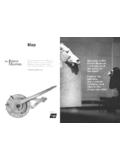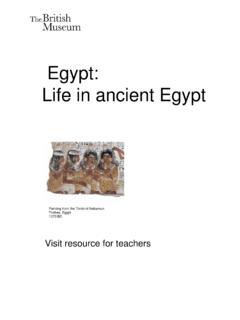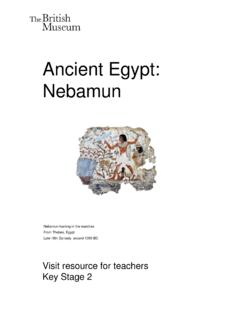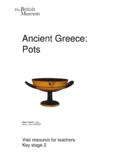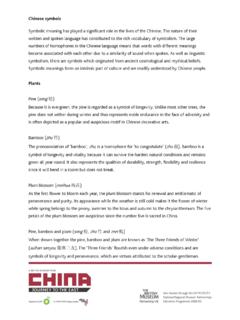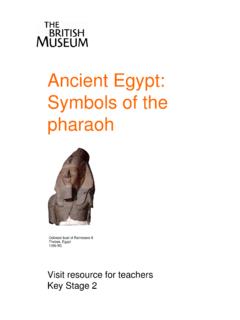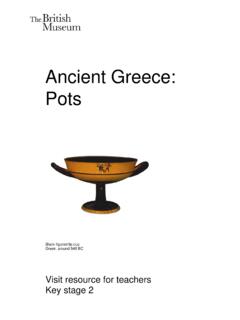Transcription of Benin: an African kingdom - British Museum - …
1 benin : an African kingdom Ivory mask of the Queen Mother benin , Nigeria probably 16th century AD 2 Ivory Salt cellar showing European traders and their ship benin , Nigeria 17th century AD 3 benin : an African kingdom Objects from the Royal Palace Until the late 19th century, one of the major powers in West Africa was the kingdom of benin in what is now southwest Nigeria. When European merchant ships began to visit West Africa from the 15th century onwards, benin came to control the trade between the inland peoples and the Europeans on the coast.
2 When the British tried to expand their own trade in the 19th century, the benin people killed their envoys. So in 1897 the British sent an armed expedition which captured the king of benin , destroyed his palace and took away large quantities of sculpture and regalia, including works in wood, ivory and especially brass. Some of these things came from royal altars for the king s ancestors, but among them were a large number of cast brass plaques made to decorate the wooden pillars of the palace. These had been left in the palace storerooms while part of the palace was being rebuilt.
3 As it later emerged, most of them were probably made between about 1550 1650, the people and scenes that they show are so many and varied that they give a vivid picture of the court and kingdom of that time. Many of the plaques and other objects from benin city were taken to Europe, where a large number of them were later given to or bought by The British Museum . When the son of the deposed king revived the benin monarchy in 1914, now under British rule, he did his best to restore the palace and continue the ancient traditions of the benin monarchy. Because these traditions are followed in the modern city of benin , it is still possible to recognise many of the scenes cast in brass by benin artists about five hundred years ago.
4 As decorations for the halls of the king s palace, the plaques were designed to proclaim and glorify the prestige of the king, his status and achievements, so they give an informative but very one-sided view of the kingdom of benin . They do not show how the ordinary people lived in the villages outside the city as farmers, growing their yams and vegetables in gardens cleared from the tropical forest. Nor do they show how most of the townspeople lived, employed in crafts such as the making of the brass plaques themselves. And most striking of all, there are no women or children shown in the plaques, which means that more than half of the people of the king s court are not shown.
5 The image of the Oba (king of benin ) appears on many plaques. To understand these images we need to know about royal regalia and the role of the king in benin society. The Oba is shown wearing a crown and tunic woven of red coral beads, which only the king and some of his supporters could wear. The coral for these beads was rare and valuable, traded from as far away as the Mediterranean. It is an appropriate symbol for the king because the prosperity of benin city and the power of its kings depended largely on long-distance trade. Long before Europeans began to sail their ships around the West African coasts, goods were being carried from the shores of the Mediterranean across the Sahara to the great trading centres of the West African savannas, such as Timbuktu, and onwards into forest regions such as benin .
6 Travelling the other way, the most valuable product of West Africa which reached Europe and Asia during the Middle Ages was gold. This was mined in the regions far to the west of benin , but it was the search for the source of this wealth which first encouraged the Europeans to sail south and east around the West African coasts. In trying to find a way around the Sahara trade routes which the Africans controlled, the Portuguese arrived in the coastal territories of benin in 1489. Thus began regular contact between the two countries which lasted 400 years. Many of the brass plaques from the king s palace show images of Portuguese men and they seem to have been made during the 16th and 17th centuries as their costumes show.
7 benin . Although benin had no gold to offer, they supplied the Portuguese with pepper, ivory, leopard skins and people, who were 4 taken as slaves to work elsewhere in Africa and in the Portuguese colonies in Brazil. Many of these people were captives taken in the wars in which the benin people conquered their neighbours far and wide and made them part of the kingdom , or they were sent by the conquered local chiefs as tribute to the king. In fact, the trade with the Portuguese probably encouraged the growth of brass casting in benin at this time. Although West Africans invented the smelting of copper and zinc ores and the casting of brass at least as long ago as the 10th century, they themselves did not produce enough metal to supply the casting industry of benin city, which gave such splendour to the king s palace.
8 The Portuguese found a ready market for brass ingots, often made in the form of bracelets called manillas . These were made in the Low Countries (modern Holland), traded throughout West Africa as a kind of currency, and melted down by the brass workers of benin . Brass manilla (bracelet) Europe probably 19th century AD 5 The figure on the right shows a Portuguese soldier. He wears a typical 16th century European costume, with steel helmet and sword, and he carries a flintlock gun. Guns were new to the people of West Africa when the Portuguese arrived. So Africans traded them from Europeans and learnt to make them for themselves, to help them in their wars against other peoples who still only had hand weapons or bows and arrows.
9 Sometimes the king of benin even employed Portuguese soldiers, like this man, to fight as mercenaries in his wars. One reason why the rulers of benin conquered their neighbours was to control the supply of goods which could be traded to the Europeans on the coast. The king himself was in charge of trading slaves, ivory and other important goods, so that all the profit went to support his court and government. Other merchants could only trade with the king s permission. The Europeans themselves were seldom allowed to travel inland or visit benin city, to avoid them trading without the authority of the king.
10 The plaques show how the people of benin perceived the Portuguese traders and their soldiers, with their pointed noses, thin faces and beards and strange clothes. Their presence on the decorations of the king s palace shows how the Portuguese were regarded as symbols of the king s wealth and power, to which their trade contributed so much. Overseas trade was one reason why the king s power was associated with water, the ocean and the river trade routes by which the European goods came to benin . It is said that an ancient king of benin once defeated the sea-god Olokun in a wrestling match on the beach and took from him the coral which the kings have used for their regalia ever since.
